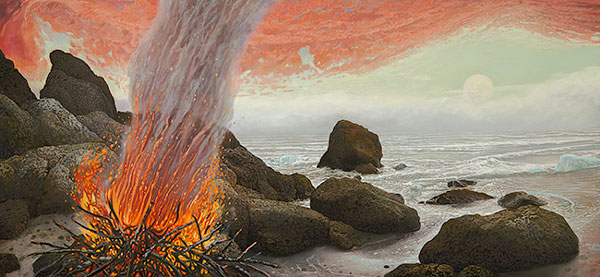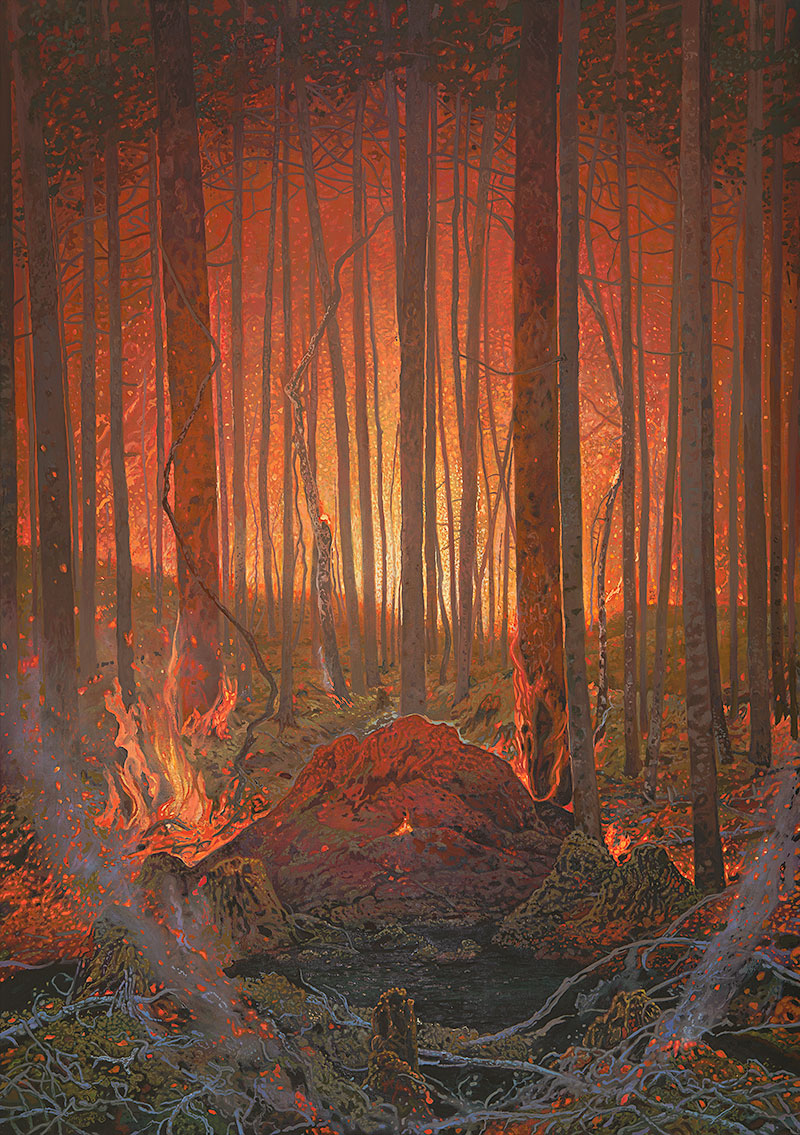Michael Scott transforms conventional landscape motifs in his new show of five large-scale oil paintings at The Autry. In these works, traditions both bucolic and catastrophic are subverted, as depictions of several varieties of hot flame and icy mist offer views of the natural world that are shot through with both psychological dimensions and mythic symbolism. These are neither idylls nor disasters. Rather, they are human-scale embodiments of powerful natural phenomena, more like portraits of fires than genres of landscape. Yet the settings are rendered with realist empathy and fine, expansive detail, giving the fires content and context for their appetites.
Fire and Ice I (2016–18) is like Thomas Cole meets Game of Thrones. The luminous moon in the upper right corner gives a nod to mythology and science fiction, while at eye level what seems like a wildfire leans hungrily out of frame, indicating the momentum of its motion. The stark compositional divide between the violet-tinged blue and molten blood orange is both elementally and optically dualistic. Like all of the pieces in the exhibition, it is by turns finely detailed and gestural as best serves the pictorial passage: snow gathered on thin dark boughs is rendered wet and crystalline; fire is abstract expressionist; atmospheres are smooth.
Geyser Mist (2013–18) has a quality of J.M.W. Turner to it, like the Harbor of Dieppe (1826), in which the fog is rife with sparkling spirits; the two painters share the ability to deploy techniques of abstraction inside forms, shapes and scenarios that express actual images and events—like fire, mist, rain, steam, fog, and smoke.

Michael Scott, Fire and Ice Pacific (2016-2018) Courtesy of the artist. Photograph by Lynn Lown, Santa Fe, NM.
Fire and Ice Pacific (2016-18) is the most surreal as well as the most narrative. The fire looks the most manmade, placed in a cozy nook of rocks, a chosen sheltered spot, its kindling laid carefully, and a pillar of thick smoke rising like a classical Ionic column. Has this been set for heat, cooking, romance, or is it a distress signal? The level sea offers no real clue as to location; the roiling clouds of late sunset unfurl deep apricot along a roughed horizon line, splendid in hue, gentle in texture, the low white sun pale as a ghost.
Most works are oriented vertically, which further transforms the usual format (horizontal is called landscape orientation, after all; but again, these are essentially portraits). This acts to give the vapors somewhere to go, to express the full dynamic of their upward trajectory. These variations on art history work because they remain tethered to Scott’s exceptional studio technique. The works are all dated in ranges, making it clear that each painting takes several years to complete. In this way too, we are brought away from the immediacy of the earth and the threats it faces, and into the longer time window of nature, art and imagination.


